History, Heritage, and Reflection
Located within the heart of Faro, the Cemitério de Faro is much more than a burial ground. Situated centrally, it is easily accessible from the old town, commercial streets, and main squares, making it a unique urb
Discover Faro’s historic cemetery, where elegant tombs and quiet gardens tell the stories of the city’s past.
The cemetery reflects centuries of the city’s social fabric, architecture, and artistic traditions, offering visitors an insightful and contemplative experience.
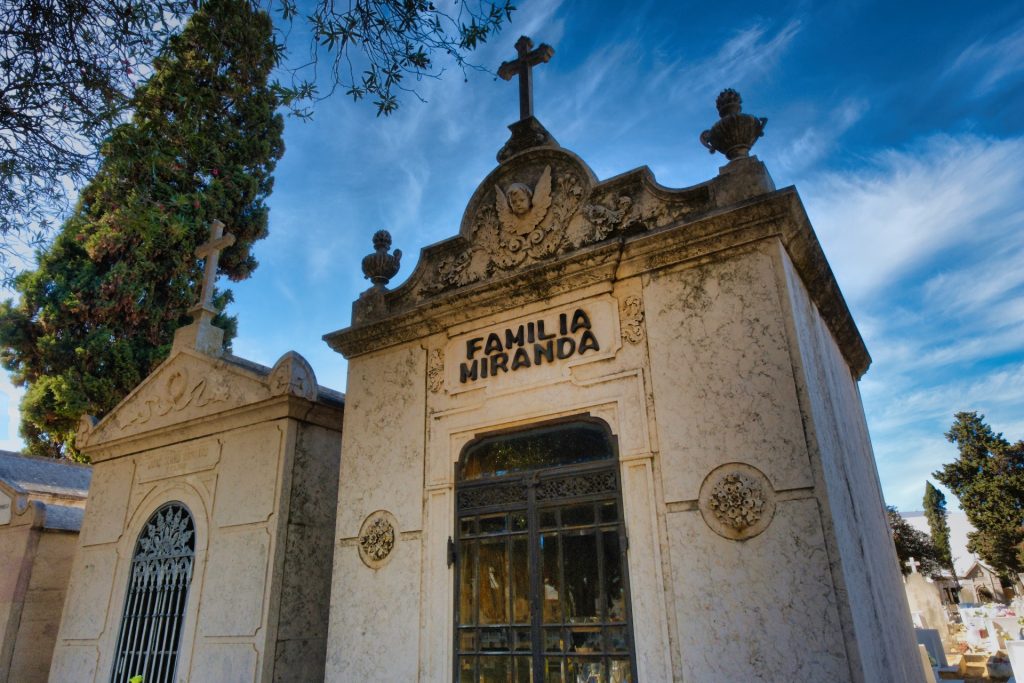
Far from being merely a burial ground, it tells the story of the community through its architecture, inscriptions, and the families whose names once shaped the city. Enclosed by whitewashed walls and shaded by tall cypress trees, it offers a quiet contrast to the bustle of the nearby marina and market area. The cemetery dates back to the 19th century, when new sanitary laws required towns to move burials outside churchyards. Like many Portuguese cemeteries from that period, it was conceived as a carefully ordered space, with paved paths and walled family tombs reflecting both social hierarchy and local aesthetic taste.
Inside, the visitor immediately notices the variety of styles that mark the evolution of funerary art in southern Portugal. Some of the earliest mausoleums are neoclassical, their clean lines and marble columns symbolizing solemnity and virtue. Others, from the turn of the 20th century, embrace eclectic or even romantic motifs, mixing Gothic arches with floral decorations or stained-glass. Many tombs bear the names of merchants, shipowners, and officials who prospered during Faro’s commercial expansion in the late 1800s, when the port handled cork, dried fruit, and salt. The cemetery therefore doubles as a small open-air museum of local history, preserving the memory of families who were instrumental in shaping the modern city.
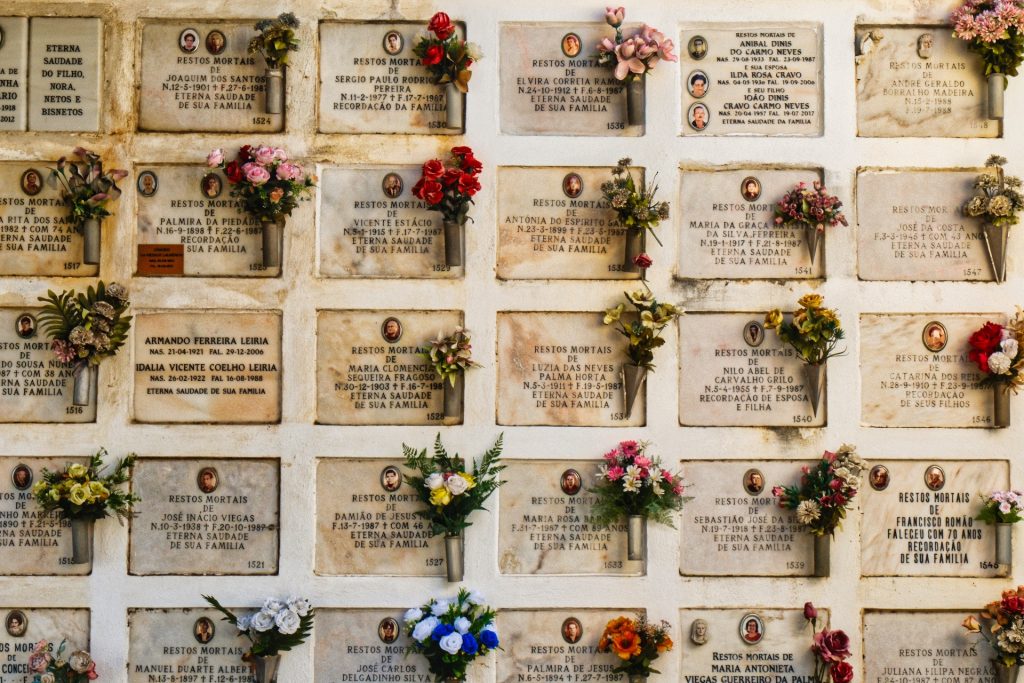
A particularly striking aspect is its organization into walled “streets” lined with miniature chapels. Each one functions as a private sanctuary, often with a wrought-iron gate through which one can glimpse photographs, vases, and small ceramic angels. The atmosphere is both melancholy and intimate, an authentic reflection of the region’s relationship with death: respectful but not distant, devotional yet deeply human. Scattered among the family tombs are simpler graves, some marked only by a cross or a weathered plaque, belonging to those who could not afford ornate mausoleums. In their simplicity lies a different kind of dignity, one that speaks of faith and community rather than wealth.
For travelers seeking to understand Faro beyond its beaches and historical landmarks, a visit provides both cultural enrichment and a window into the lives of past citizens.
Origins and Historical Significance
This cemetery was established in the 19th century, at a time when expanding urban populations and public health considerations made churchyard burials impractical. Before this, Faro’s deceased were primarily interred in church grounds throughout the city, which became increasingly unsuitable as the city grew. It was created to offer a more organized and sanitary alternative, reflecting broader European trends of the era toward landscaped, dedicated spaces for the deceased.
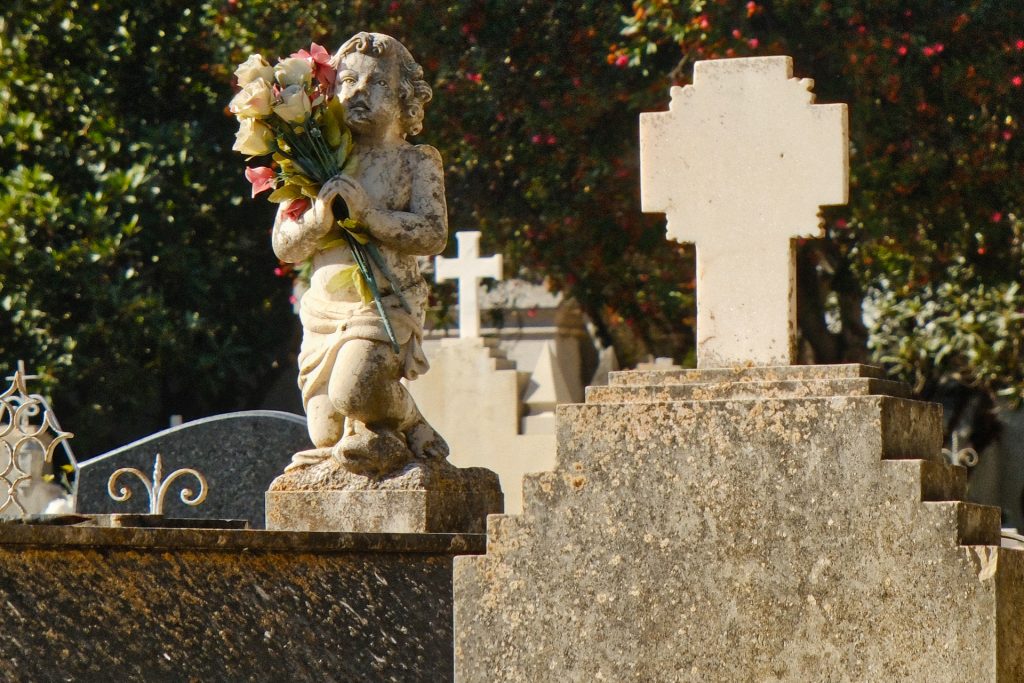
Although precise records of the earliest burials are limited, the cemetery quickly became the main burial site for Faro. Its central location allowed it to remain accessible to families while still providing a peaceful environment for reflection. Over the decades, it grew to accommodate the city’s population and evolved architecturally to incorporate the styles of successive periods.
Layout and Design
The cemetery is arranged along a structured network of paths, lined with trees and ornamental shrubs, giving it a serene and almost park-like quality despite its urban location. Its layout balances functional organization with aesthetic considerations, typical of 19th- and early 20th-century Portuguese cemeteries.
Graves range from modest headstones to elaborate family mausoleums, showcasing neoclassical, neo-Gothic, and art nouveau styles. Marble and granite dominate, while sculptural details, symbolic motifs such as angels or crosses, and carefully inscribed epitaphs offer insight into the personal histories of the interred. This architectural richness makes this place both a historical record and an open-air museum of funerary art.
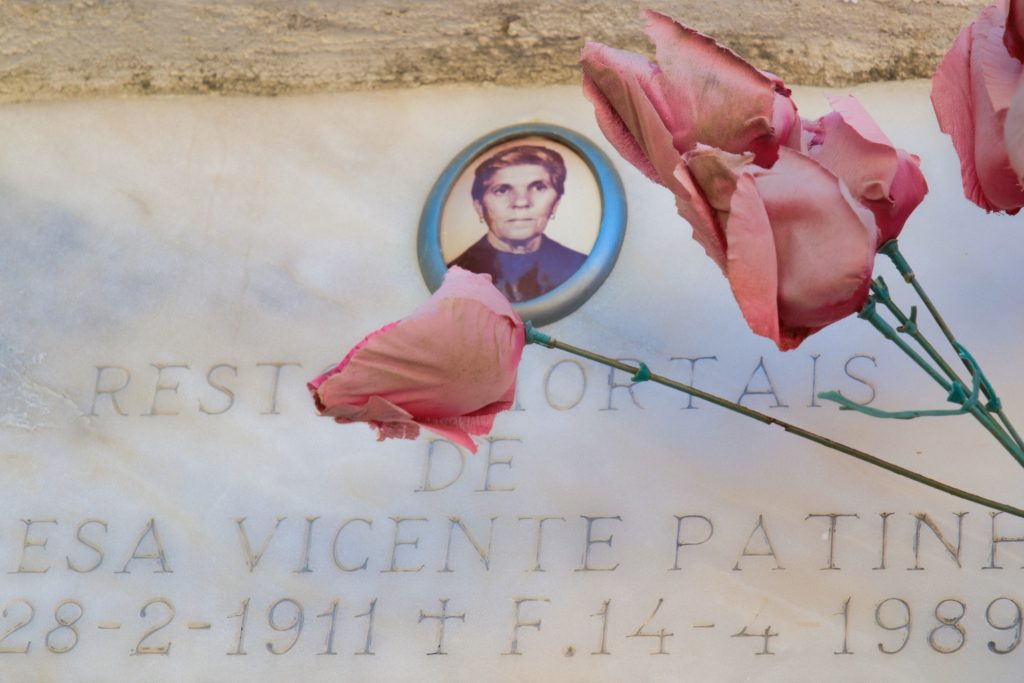
Despite its age, the cemetery remains in active use, carefully maintained by the municipality. It is open to visitors during daytime hours, and locals still come not only to tend to graves but also to stroll in its shaded alleys. For those interested in Faro’s cultural heritage, the place is an unexpected but rewarding stop: it offers an unfiltered view of local history, where architecture, memory, and emotion meet. In this place, the social past of Faro—the rise of bourgeois families, the transformations of faith, the echo of maritime life—remains carved in stone, waiting to be quietly read.
Famous and Notable Tombs
Among the many existent graves, several stands out for their historical or cultural significance. Faro has long been home to prominent figures in politics, literature, and civic life, and many are buried here.
One noteworthy figure connected to the city is João de Deus, the celebrated poet and educator, whose memorials tie him to Faro’s civic and cultural identity. Other notable tombs include those of influential military officers and families who shaped Faro’s development during the 19th and early 20th centuries.

The mausoleums themselves are works of art. Many feature wrought iron gates, marble statues, and tiled details, reflecting the tastes and social status of those interred. Some epitaphs recount personal stories of emigration, professional achievement, or family legacy, linking Faro to wider regional and international histories.
Cultural and Religious Context
The Cemetery of Faro primarily follows Catholic traditions, with crosses, saints, and religious inscriptions widely represented. Annual observances such as All Saints’ Day – 1st November (Dia de Todos os Santos) see families returning to honor their ancestors, clean graves, and leave flowers, reflecting the enduring importance of family and memory in Portuguese culture.
The cemetery also reflects Faro’s religious diversity and the passage of time. There are sections for non-Catholic burials, a reminder of the city’s connections with foreign residents and traders, particularly from Britain and the Netherlands, who settled here in the 19th century. A few graves carry inscriptions in English or French, while others bear symbols rather than words—an anchor for sailors, a palm branch for peace, or the Sacred Heart, so typical of Portuguese devotion. Over the decades, restorations and neglect have alternated, and some tombs now stand in quiet decay, their marble cracked and their lettering softened by the sea air.
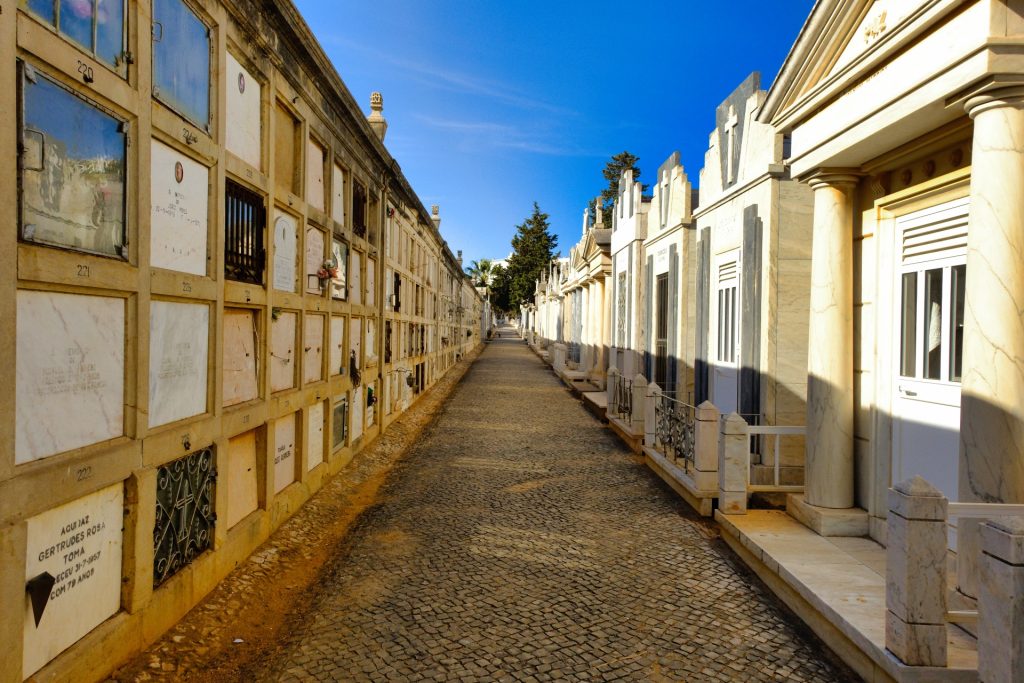
Although rooted in religious tradition, the cemetery also attracts visitors interested in history, architecture, or genealogy. Its tranquil atmosphere and urban centrality provide a contemplative retreat in the midst of Faro’s bustling streets, allowing tourists to appreciate both the city’s past and present.
Nearby Points of Interest
Thanks to its central location, the cemetery is close to most landmarks in town. The Old Town is within easy walking distance, providing historical context for the families interred here. Nearby churches, such as the Igreja do Carmo, with its Chapel of Bones, and public buildings contribute further insight into Faro’s religious and civic heritage.
For those researching genealogy or local history, the Municipal Archives and Library are accessible within the city center, offering potential access to burial registries and historical records.
Reflection and Experience
A visit to the Cemetery offers both a contemplative and educational experience. Beyond the artistic tombs and monuments, visitors encounter the rhythms of urban life and the quiet dignity of the city’s past citizens. Trees, flowering shrubs, and pathways create a meditative atmosphere that contrasts with the surrounding bustling streets, inviting reflection and appreciation of history.

For tourists, this central burial ground complements visits to the beaches, gardens, and museums, highlighting the city’s layered history and the artistic and social values of generations past. Many visitors leave with a deeper understanding of Faro’s identity, shaped as much by its people and their stories as by its architecture or coastline.
Practical Information for Visitors
The Cemetery of Faro is centrally located on Rua do Cemitério, within easy walking distance from the old town and city center. It is accessible on foot from most central hotels and squares. Street parking is available nearby.
Paths are generally well-paved, though older sections can be uneven, so comfortable footwear is recommended. Early morning or late afternoon visits are particularly atmospheric, when soft light enhances the details of tombs, mausoleums, and monuments. While guided tours are uncommon, self-guided exploration is easy, and visitors are free to walk at their own pace, read inscriptions, and observe architectural details. Photography is permitted, but respectful conduct is advised.
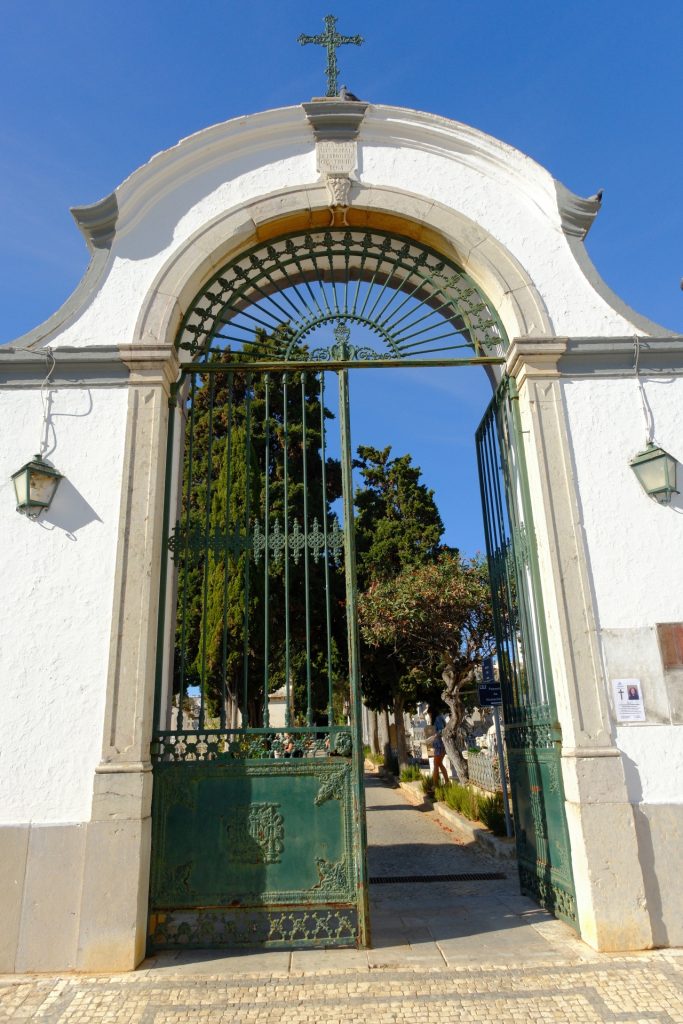
It’s open daily from early morning until late afternoon (a bell will sound when it’s about to close), with free entry. Comfortable footwear is recommended due to uneven terrain in older sections. Visitors are expected to maintain respectful behavior at all times, keeping voices low and refraining from disturbing ongoing ceremonies. Self-guided exploration is straightforward, with clear paths throughout the grounds. Informational brochures or maps may occasionally be obtained at the entrance or from the tourist office.




